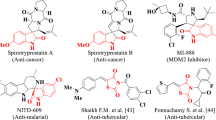Abstract
Isocitrate lyase (ICL) is envisaged as an attractive drug target for the development of antimicrobial agents. We have prepared a series of hydroquinone derivatives on the basis of the structure of halisulfates, a naturally occurring inhibitor of ICL. The obtained derivatives were evaluated against ICL ofC. albicans. The preliminary structure-activity relationships and the minimal structural requirements for potency were established through structural modifications.
Similar content being viewed by others
References
Abdul Lattif, A., Prasad, R., Banerjee, U., Gupta, N., Mohammad, S., and Baquer, N. Z., The glyoxylate cycle enzyme activities in the pathogenic isolates ofCandida albicans obtained from HIV/AIDS, diabetic and bum patients.Mycoses, 49, 85–90 (2006).
Berman, J. and Sudbery, P. E.,Candida albicans: A molecular revolution built on lessons from budding yeast.Nat. Rev. Genet, 3, 918–932 (2002).
Britton, K. L., Langridge, S. J., Baker, P. J., Weeradechapon, K., Sedelnikova, S. E., De Lucas, J. R., Rice, D. W., and Turner, G., The crystal structure and active site location of isocitrate lyase from the fungusAspergillus nidulans.Structure, 8, 349–362 (2000).
Calderone, R. A. and Fonzi, W. A., Virulence factors ofCandida albicans.Trends Microbiol., 9, 327–335 (2001).
Chatterjee, A. K., Choi, T. -L., Sanders, D. P., and Grubbs, R. H., A general model for selectivity in olefin cross metathesis.J. Am. Chem. Soc., 125, 11360–11370 (2003).
Chatterjee, A. K., Toste, F. D., Choi, T. -L., and Grubbs, R. H., Ruthenium-catalyzed olefin cross metathesis of styrenes as an alternative to the Heck and cross-coupling reactions.Adv. Synth. Catal., 344, 634–637 (2002).
Connon, S. J. and Blechert, S., Recent developments in olefin cross-metathesis.Angew. Chem., Int. Ed., 42, 1900–1923 (2003).
Ebel, F., Schwienbacher, M., Beyer, J., Heesemann, J., Brakhage, A. A., and Brock, M., Analysis of the regulation, expression, and localisation of the isocitrate lyase fromAspergillus fumigatus, a potential target for antifungal drug development.Fungal Genet. Biol., 43, 476–489 (2006).
Goldstein, A. L. and McCusker, J. H., Development ofSac-charomyces cerevisiae as a model pathogen: a system for the genetic identification of gene products required for survival in the mammalian host environment.Genetics, 159, 499–513 (2001).
Hautzel, R., Anke, H., and Sheldrick, W. S., Mycenon, a new metabolite from aMycena species TA 87202 (basidiomycetes) as an inhibitor of isocitrate lyase.J. Antibiot., 43, 1240–1244 (1990).
Howard, B. M., Clarkson, K., and Bernstein, R. L., Simple prenylated hydroquinone derivatives from the marine urochordateAplidium califomicum. Natural anticancer and antimutagenic agents.Tetrahedron Lett., 46, 4449–4452 (1979).
Kaposzta, R., Marodi, L., Hollinshead, M., Gordon, S., and Da Silva, R. P., Rapid recruitment of late endosomes and Iyso-somes in mouse macrophages ingestingCandida albicans.J. Cell. Sci., 112, 3237–3248 (1999).
Kawagishi, H., Hamajima, K., and Inoue, Y., Novel hydroquinone as a matrix metallo-proteinase inhibitor from the mushroom,Piptoporus betulinus.Biosci. Biotechnol. Biochem., 66, 2748–2750 (2002).
Kim, S. -Y., Park, J. -S., and Oh, K. -B., Effects of isocitrate lyase inhibitors on spore germination and appressorium development inMagnaporthe grisea.J. Microbiol. Biotechnol., 16, 1158–1162 (2006).
Ko, Y. H. and McFadden, B. A., Alkylation of isocitrate lyase fromEscherichia coli by 3-bromopyruvate.Arch. Biochem. Biophys., 278, 373–380 (1990).
Ko, Y. H., Vanni, P., and McFadden, B. A., The interaction of 3-phosphoglycerate and other substrate analogs with the glyoxylate- and succinate-binding sites of isocitrate lyase.Arch. Biochem. Biophys., 274, 155–160 (1989).
Lee, H. -S., Lee, T. -H., Yang, S. H., Shin, H. J., Shin, J., and Oh, K. -B., Sesterterpene sulfates as isocitrate lyase inhibitors from tropical spongeHippospongia sp.Bioorg. Med. Chem. Lett., 17, 2483–2486 (2007).
Lee, K. C., Moon, B. S., Lee, J. H., Chung, K. -H., Katzenellenbogen, J. A., and Chi, D. Y., Synthesis and binding affinities of fluoroalkylated raloxifenes.Bioorg. Med. Chem., 11, 3649–3658 (2003).
Lorenz, M. C., Bender, J. A., and Fink, G. R., Transcriptional response ofCandida albicans upon intemalization by macrophages.Eukaryotic Cell, 3, 1076–1087 (2004).
Lorenz, M. C. and Fink, G. R., Life and death in a macrophage: role of the glyoxylate cycle in virulence.Eukaryotic Cell, 1, 657–662 (2002).
Lorenz, M. C. and Fink, G. R., The glyoxylate cycle is required for fungal virulence.Nature, 412, 83–86 (2001).
McFadden, B. A. and Purohit, S., Itaconate, an isocitrate lyase- directed inhibitor inPseudomonas indigofera.J. Bacteriol., 131, 136–144 (1977).
Schloss, J. V. and Cleland, W. W., Inhibition of isocitrate lyase by 3-nitropropionate, a reaction-intermediate analog.Biochemistry, 21, 4420–4427 (1982).
Shin, D. -S., Kim, S., Yang, H. -C., and Oh, K. -B., Cloning and expression of isocitrate lyase, a key enzyme of the glyoxylate cycle, ofCandida albicans for development of antifungal drugs.J. Microbiol. Biotechnol., 15, 652–655 (2005).
Snider, B. B. and Lu, Q., Total Synthesis of (+/-)-Leporin A.J. Org. Chem., 61, 2839–2844 (1996).
Tadahiro, K., Shin-Ichi, E., Tohru, F., Hirota, T., and Masahiro, H., Synthesis of (1S, 2R, 12S)-2-hydroxy-11-dihydroneocembrene.Tetrahedron Asymmetry, 10, 3691–3700 (1999).
Author information
Authors and Affiliations
Corresponding author
Rights and permissions
About this article
Cite this article
Yang, HC., Yu, J., Oh, KB. et al. Synthesis and evaluation of hydroquinone derivatives as inhibitors of Isocitrate Lyase. Arch Pharm Res 30, 955–961 (2007). https://doi.org/10.1007/BF02993963
Received:
Issue Date:
DOI: https://doi.org/10.1007/BF02993963




